Key takeaways:
- Animal welfare is interconnected with public health and enriches community empathy through the recognition of animals’ emotions and needs.
- Animal protection societies play a crucial role in education, advocacy, and community engagement, inspiring individuals to volunteer and adopt.
- Organizing local events and leveraging social media facilitates community involvement, fostering connections and awareness around animal welfare issues.
- Sharing personal success stories can motivate others to participate in animal welfare efforts, creating a collective movement within the community.
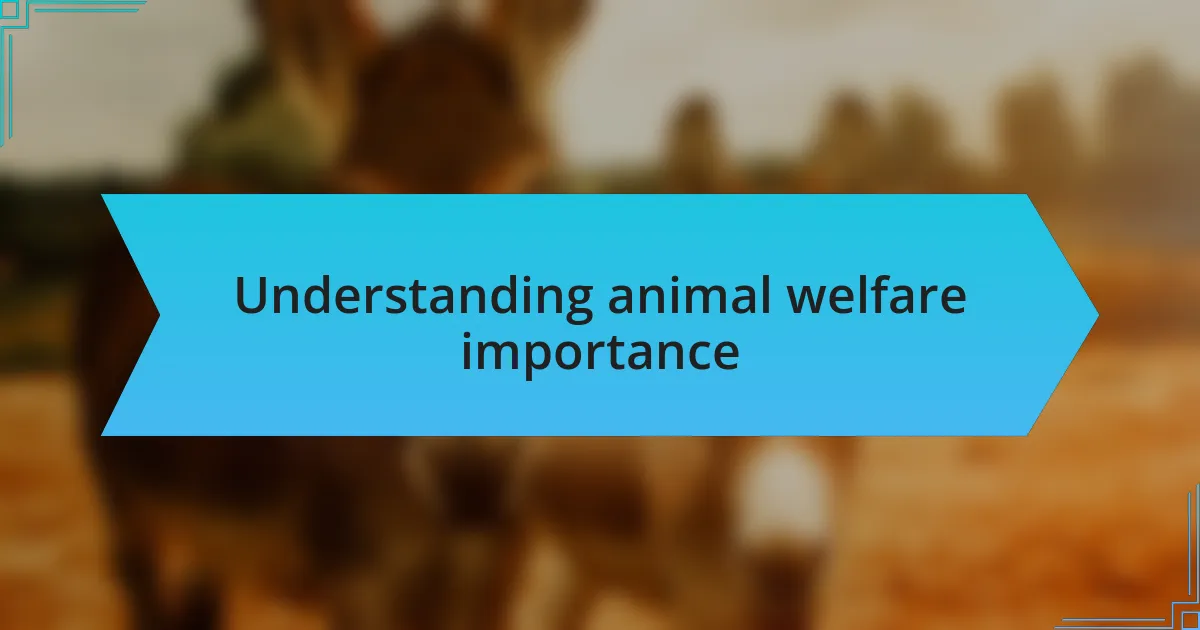
Understanding animal welfare importance
Animal welfare is crucial because it reflects our values as a society. I remember the first time I witnessed an abandoned dog on my street. It struck me deeply; that moment made me realize how interconnected our well-being is with the animals around us. They experience pain, joy, and fear just like we do, and acknowledging that is the first step toward fostering a compassionate community.
When we prioritize animal welfare, we also protect public health. For instance, a well-cared-for animal is less likely to transmit diseases, which can benefit everyone in the neighborhood. I often wonder, how many of us take this connection for granted? It’s not just a matter of being kind; it’s about creating a safer environment for us all.
Furthermore, animals provide companionship, emotional support, and a sense of purpose. In my own experience, adopting a pet transformed my life. Have you ever felt the joy of a wagging tail when you come home? Understanding the importance of animal welfare isn’t just about the animals; it’s about enriching our lives and cultivating empathy in our communities.
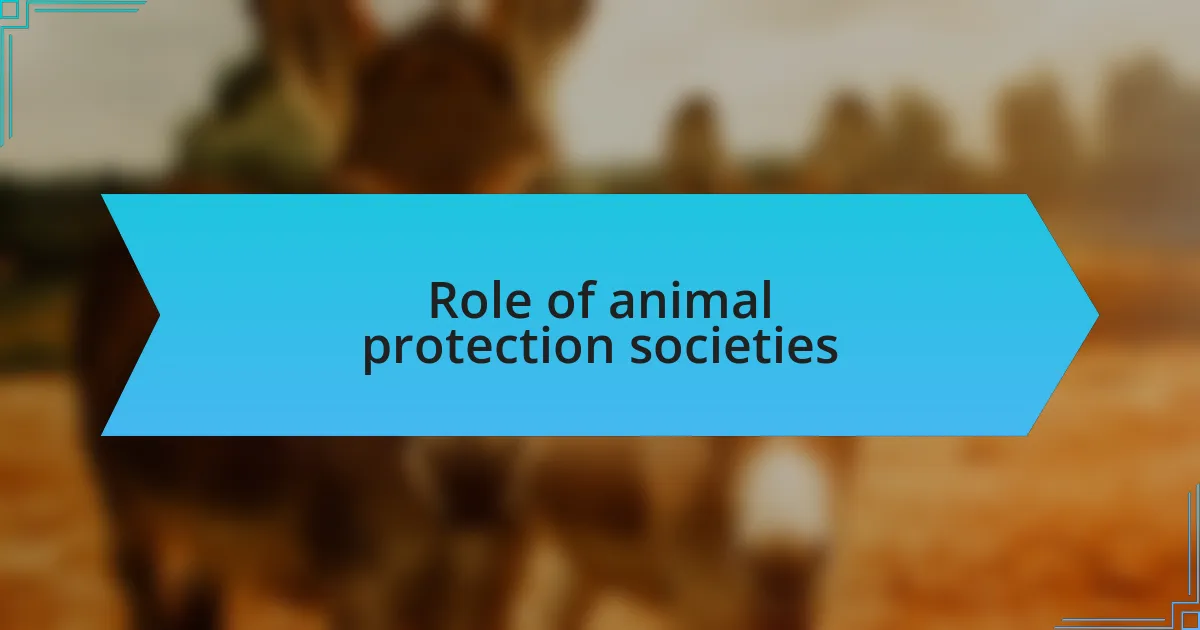
Role of animal protection societies
Animal protection societies play a pivotal role in raising awareness about the importance of treating animals with respect and dignity. In my experience attending local outreach events, I’ve seen firsthand the powerful impact these organizations can have on a community. When folks learn about the stories of rescued animals, it often sparks a desire to get involved, whether through volunteering, donating, or adopting.
These societies also serve as vital resources for education, providing crucial information on proper pet care, wildlife conservation, and humane treatment standards. I recall a workshop I attended—at first, I thought I was just going to learn a few tips about dogs, but it became so much more. Understanding the broader issues, like the significance of spaying and neutering, opened my eyes to the large-scale impact we can have on reducing animal homelessness.
Moreover, animal protection societies often work closely with local governments to ensure that laws protecting animals are enforced and improved. I remember a community meeting where a society representative shared how laws on leash regulations were updated, resulting in safer parks for both animals and humans. It made me think, how can we ensure that these voices are heard? Supporting these societies gives them the power to advocate for positive change, leading to a healthier coexistence between humans and animals.
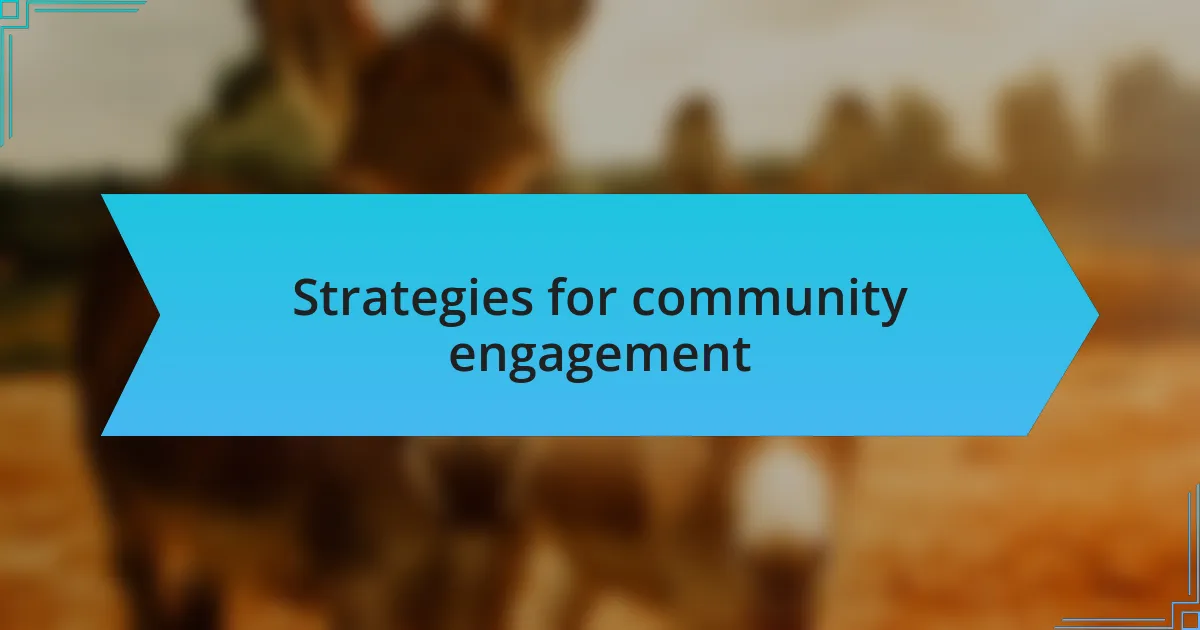
Strategies for community engagement
One effective strategy for community engagement is organizing local events centered around animal welfare, such as pet adoption fairs or educational workshops. I experienced this firsthand when I helped coordinate a neighborhood dog show. The joy and excitement on the faces of families interacting with the adoptable pets was incredibly rewarding—it’s amazing how a simple event can bring people together for a common cause.
Creating volunteer opportunities is another important tactic. When I opened my home to foster animals for a local shelter, it not only helped the animals but also encouraged friends and neighbors to get involved. I often wondered, what if everyone had the chance to foster even one pet? This single act could create ripples of kindness and compassion throughout our community, inspiring others to take action.
Lastly, leveraging social media can significantly enhance outreach efforts. I started a community Facebook group focused on animal welfare, which quickly grew in membership. It became a platform where members shared stories, resources, and photos of their pets, fostering a sense of camaraderie. Have you considered how online connections could translate into real-world impact? By nurturing these relationships, we create a dynamic support system dedicated to the welfare of animals in our neighborhoods.
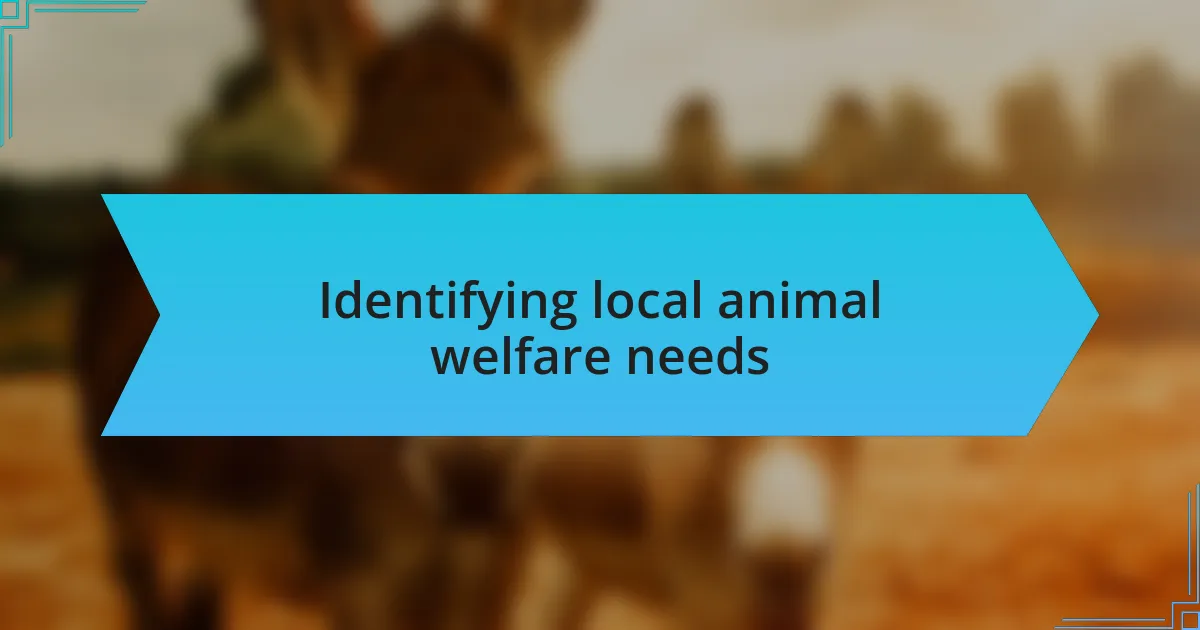
Identifying local animal welfare needs
To identify local animal welfare needs, I first took the time to speak with neighbors about their concerns and experiences with animals in our area. During one conversation over coffee, a neighbor shared her frustration about the stray cat population and how it affected her backyard garden. That moment opened my eyes to specific needs in our community that I hadn’t considered before, making me realize the importance of listening to people’s stories.
Another approach that proved valuable was conducting a simple survey in our community. I created a quick questionnaire that asked residents about their thoughts on animal welfare issues. The responses were enlightening; for instance, many participants expressed a desire for more resources to help lost pets find their way home. It struck me how powerful it is to give people a voice and find common ground in our shared goal of improving animal welfare.
Lastly, I partnered with a local veterinarian to host informal discussions about animal care and welfare needs. One evening, as we gathered with pet owners, several attendees voiced concerns about affordable veterinary services. The passion in the room was palpable, and it made me think—how can we work together to address these pressing issues? This collaborative spirit became the foundation of our future initiatives, demonstrating how community engagement can uncover critical animal welfare needs.
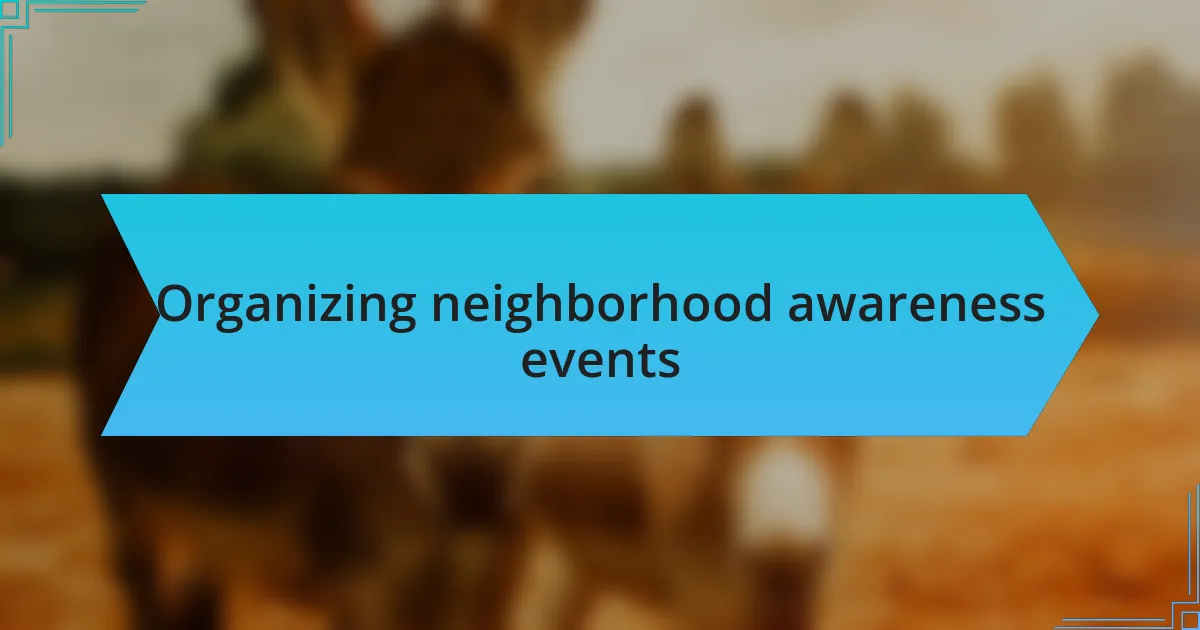
Organizing neighborhood awareness events
In planning neighborhood awareness events, I realized that creating a sense of community is essential. One weekend, I organized a small gathering at the local park, inviting residents to bring their pets along. Watching families come together, sharing stories about their furry friends while enjoying a picnic, I felt a strong sense of camaraderie developing—a vital first step in fostering an engaged community.
During these events, I made it a point to include educational activities. We set up tables where volunteers shared information about local wildlife, the importance of spaying and neutering, and how to care for stray animals. One evening, it struck me to ask a simple question: “What do you wish you knew about animal welfare?” The diverse answers prompted deeper conversations, enhancing awareness and forging stronger bonds among attendees.
Reflecting on the impact of these gatherings, I noticed that they became platforms for collaboration. After one session focused on stray animal care, a neighbor approached me with her ideas for a fundraising event for our local shelter. Her enthusiasm inspired me, reminding me that when people feel informed and connected, they often take the initiative themselves. Isn’t it remarkable how a shared experience can ignite passion and drive change?
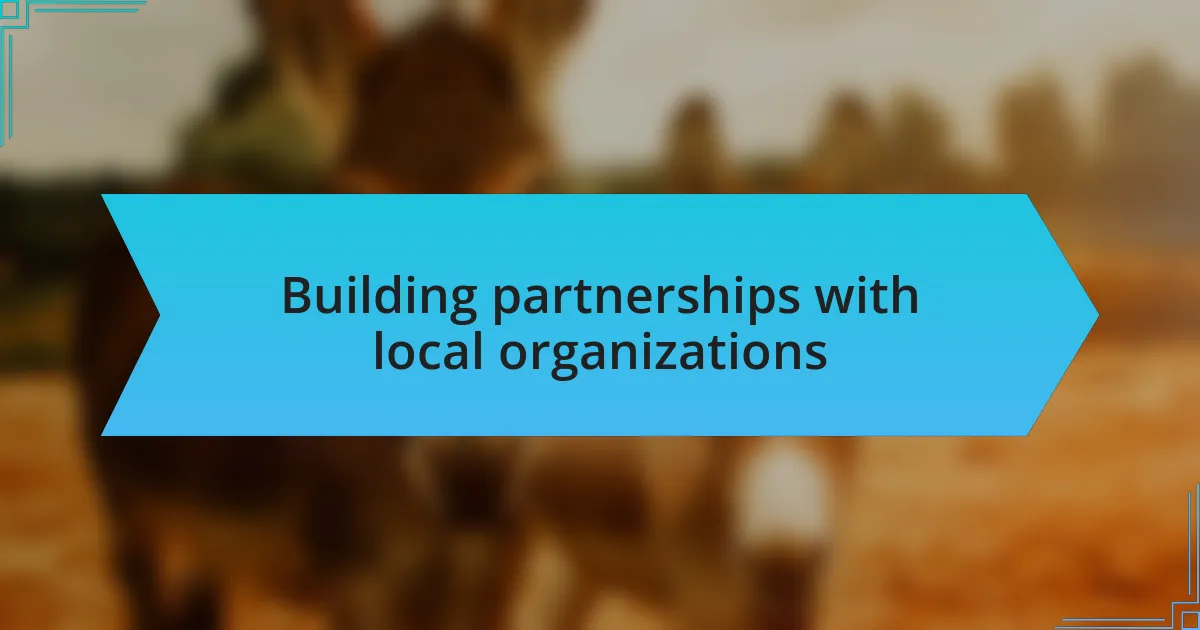
Building partnerships with local organizations
Building partnerships with local organizations was a game changer for my community efforts. I remember reaching out to a nearby animal shelter, and the director was enthusiastic about collaboration. That initial conversation led to joint workshops where we not only educated residents but also connected them with resources for adopting pets. Have you ever felt that spark of possibility when two entities come together for a common cause? It’s invigorating!
Engaging local businesses was another rewarding experience. I approached a pet supply store, and to my delight, they agreed to sponsor an event. They donated supplies and even offered discounts to attendees, creating a win-win scenario. I was blown away by the store’s willingness to contribute. Isn’t it amazing how businesses can play a pivotal role in community initiatives? Their involvement not only bolstered our resources but also showcased their commitment to animal welfare, strengthening their relationship with community members.
One day, we organized a clean-up day at a local park in partnership with a conservation group. As we worked side by side, I was struck by the diverse backgrounds of the volunteers, all united by a love for animals and nature. I realized that these partnerships didn’t just help with our immediate goals; they fostered an ongoing dialogue about animal welfare issues. How transformative is it when organizations align efforts? This collaborative spirit is not only inspiring but vital for sustaining animal protection efforts in our neighborhood.
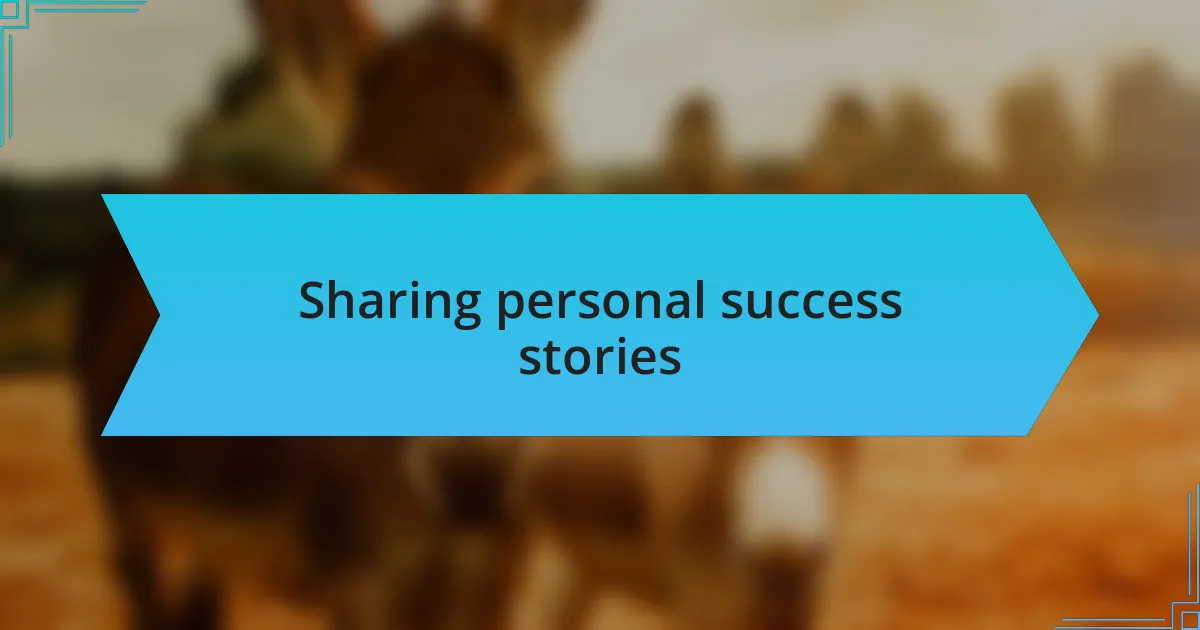
Sharing personal success stories
Sharing personal success stories has a profound impact on inspiring others to get involved. I remember the day I shared my own journey of rescuing a stray dog with my neighbors. Their reactions were heartfelt; many expressed their surprise at how one small act could lead to such a fulfilling experience. Isn’t it amazing how our stories can spark a connection and motivate others to take action?
One particularly memorable success story occurred when a neighbor decided to open their home to a group of kittens after hearing about my experiences fostering animals. Watching them transform from frightened and timid to playful and loving was beautiful. It made me realize how a simple conversation about my involvement in animal welfare could lead to substantial change in someone’s life perspective. How often do we underestimate the power of sharing our experiences?
In our neighborhood, success stories have spread like wildfire. After I organized a community event focused on spaying and neutering, several attendees began sharing their own stories of animals they had helped. The ripple effect was stunning; soon, they were recruiting friends and family to join us in our mission. This collective sharing not only reinforced our commitment but also created a profound sense of belonging among us. Have you ever felt that warmth of a community coming together around a common goal? It’s truly uplifting.